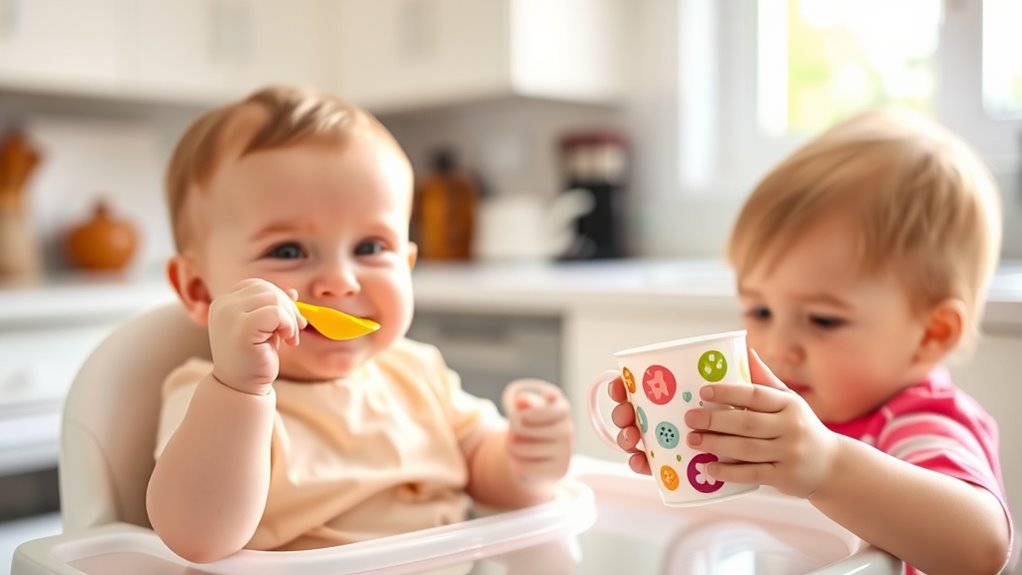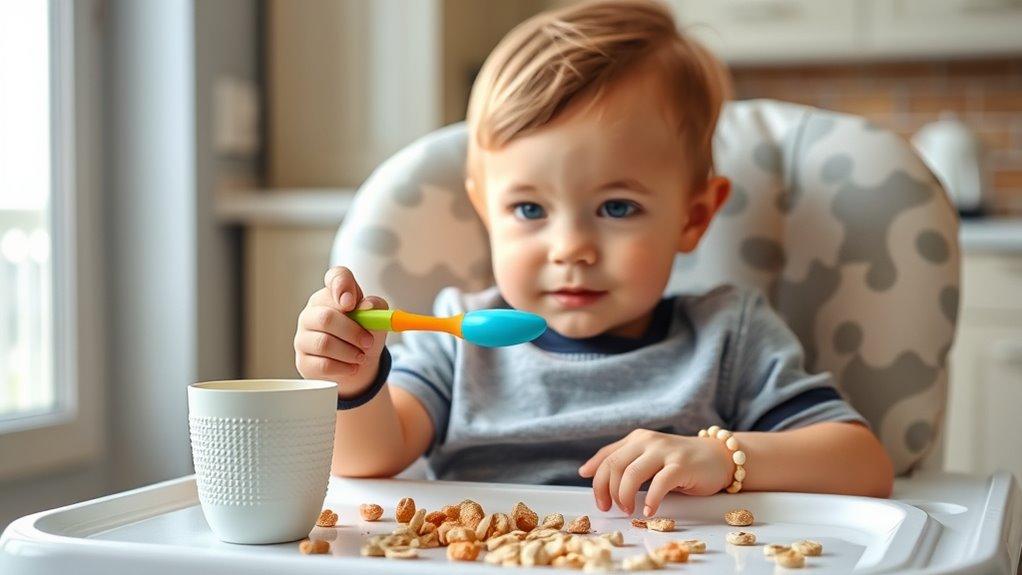To teach your baby to use a spoon and cup, choose age-appropriate, easy-grip utensils with non-slip handles and safe materials. Create a calm mealtime environment with routine and minimal distractions, and model proper use yourself. Be patient and encourage practice with short sessions, celebrating small successes along the way. Expect messes and challenges, but keep mealtimes fun and engaging. With consistent effort and positive reinforcement, you’ll see progress—and there’s more to learn as you continue.
Key Takeaways
- Choose ergonomic, safe utensils with non-slip grips and suitable materials to promote easy handling.
- Model proper techniques and encourage imitation through patient demonstration and positive reinforcement.
- Keep mealtime routines consistent, calm, and distraction-free to foster focus and confidence.
- Celebrate small milestones and progress to motivate continued practice and build independence.
- Provide age-appropriate, nutritious foods and supervise closely to ensure safe, healthy self-feeding habits.
Selecting the Right Utensils for Your Baby

When choosing utensils for your baby, it’s important to prioritize safety and ease of use. Focus on selecting ergonomic utensils that fit comfortably in tiny hands, making self-feeding easier and more enjoyable. Look for utensils with rounded edges and non-slip grips to prevent accidents and encourage independence. Equally important is selecting safe materials—opt for BPA-free, dishwasher-safe plastics or silicone that won’t leach harmful chemicals. Avoid utensils with sharp edges or small parts that could pose a choking hazard. The right utensils will help your baby develop their fine motor skills while feeling confident during mealtime. By choosing ergonomic utensils made from safe, high-quality materials, you set a strong foundation for your child’s self-feeding journey. Incorporating safe, durable materials in utensils contributes to both safety and longevity, ensuring they withstand active use and frequent cleaning. Additionally, selecting utensils with appropriate sizing and design can further promote independence and confidence during meals. Using utensils with ergonomic features can also help your baby improve hand-eye coordination and dexterity more effectively, especially when considering a variety of utensil types that suit different stages of development.
Creating a Positive Mealtime Environment

A positive mealtime environment encourages your baby to enjoy eating and develop healthy habits. Establishing consistent mealtime routines helps your baby feel secure and know what to expect, making mealtimes more enjoyable. Keep distractions to a minimum by turning off screens, limiting toys, and creating a calm setting. This focus allows your baby to pay attention to their food, learn about textures and tastes, and build self-feeding skills. Sit together at the table, maintain a relaxed atmosphere, and offer encouraging words. By creating a peaceful environment, you promote positive associations with mealtime, making it easier for your baby to develop independence and confidence with self-feeding. Additionally, digital literacy programs can support your child’s development of communication skills and familiarity with technology, which are increasingly important. Incorporating positive reinforcement techniques can further motivate your baby to try new foods and embrace self-feeding. Remember, patience and consistency are key to fostering a love for eating.
Demonstrating Proper Spoon and Cup Use

To help your baby develop confidence in self-feeding, it’s important to demonstrate proper spoon and cup use. Your actions teach your little one how to handle utensils, fostering independence. Here are three tips to effectively demonstrate:
- Show, don’t just tell—use clear, slow movements while guiding the spoon or cup.
- Let your baby watch you scoop food and lift the cup, highlighting the correct technique.
- Encourage your baby to imitate your actions, offering praise to reinforce learning.
- Incorporating familiar tools like a small training cup can make the learning process more engaging and effective, which can help align your child’s development with positive learning experiences. Additionally, consistent demonstrations can support the development of self-feeding skills and boost your child’s confidence during mealtime. Using demonstration techniques that include patience and repetition can significantly improve your child’s ability to master self-feeding. Understanding how tuning strategies influence motor skills can also be beneficial in creating effective teaching methods.
Encouraging Practice and Patience

Encouraging your baby to practice self-feeding requires patience and consistent support. Remember, patience building takes time, and celebrating small successes boosts confidence. Offer gentle encouragement to foster encouraging independence, even when messes happen. To help, try creating a structured routine that allows your baby to practice regularly without pressure. Use this table to guide your approach:
| Tip | Why it helps | Example |
|---|---|---|
| Keep sessions short | Prevents frustration | 5-10 minute practice blocks |
| Offer praise and encouragement | Builds confidence | “Great job trying!” |
| Be patient with messes | Promotes learning from mistakes | Wiping hands calmly after spills |
| Model proper use | Reinforces correct techniques | Demonstrate spoon use yourself |
Additionally, understanding the importance of credit card monitoring can help parents teach responsible financial habits early on. Patience and encouragement are key to helping your baby develop self-feeding skills confidently.
Handling Common Challenges During Self-Feeding

Handling common challenges during self-feeding can be tricky, but with the right approach, you can make it easier for your child. Picky eaters might resist certain foods, so try different textures and flavors to find what works. Expect spills and messes—they’re normal—and having a plan to clean up helps keep mealtime stress-free. Incorporating essential oils for calming effects, such as lavender, can also create a relaxing environment that encourages positive self-feeding habits. Understanding the divorce process and requirements in your area can help reduce stress if family changes are involved, providing a sense of stability for your child. Recognizing and addressing emotional responses during mealtime can help your child develop a healthier attitude toward eating and self-feeding.
Tips for Picky Eaters
Picky eaters can make self-feeding a challenging experience, but understanding their preferences and frustrations is key to overcoming these hurdles. To encourage better eating habits, focus on establishing consistent mealtime routines that create a predictable environment. Offer a variety of snack options to keep your child interested and avoid mealtime battles. Here are some tips to help:
- Respect their preferences by introducing new foods gradually and without pressure.
- Keep mealtime routines consistent to build familiarity and comfort.
- Provide appealing snack options that complement their self-feeding skills, such as cut fruits or soft crackers.
- Monitoring bowel movements and ensuring proper hydration can support overall digestion and comfort during self-feeding. Incorporating textile art concepts like layering textures in your child’s utensils or placemats can make the experience more engaging. Additionally, incorporating aesthetic wall organization ideas can create a more inviting mealtime space that encourages independence.
- Recognizing the importance of angel numbers and spiritual guidance can offer reassurance and patience during this developmental phase, fostering a positive attitude toward self-feeding. Additionally, understanding the importance of nutritional balance can help you select foods that meet your child’s growth needs while accommodating their preferences.
Patience and flexibility are essential. Over time, these strategies can turn picky eating into a positive self-feeding experience.
Managing Spills and Messes
Managing spills and messes is a natural part of your child’s self-feeding development, and it’s important to approach these challenges with patience. When cleaning up spills, stay calm and use a simple cloth or paper towels to quickly manage messes, helping your child feel supported rather than discouraged. Encourage your child to participate in managing messes by helping wipe their face and hands, fostering independence. Setting up a designated area with easy-to-clean surfaces and using spill-proof cups or bowls can reduce messes. Remember, frequent cleaning is part of the learning process, and patience helps your child develop confidence in self-feeding. Managing messes calmly teaches your child that spills are okay and part of learning to eat independently. Incorporating consistent messaging about handling messes can also strengthen your child’s understanding and resilience during self-feeding.
Incorporating Fun and Engagement in Practice

Have you ever wondered how to make self-feeding practice enjoyable for your child? Incorporating fun keeps them engaged and enthusiastic to learn. Here are three ideas to boost their enthusiasm:
- Use music and mealtime together—sing songs or play their favorite tunes to turn eating into a lively event.
- Tell stories involving utensils—create simple tales where spoons and cups are characters, sparking their imagination.
- Make it interactive—encourage them to choose their utensils or utensils with bright colors, making the experience personalized and exciting.
These approaches turn routine practice into a playful activity, helping your child associate self-feeding with fun. Remember, engaging them with music, storytelling, and choice keeps the process lively and rewarding.
Recognizing and Celebrating Progress

You’ll want to notice when your child reaches a new milestone or shows improvement, no matter how small. Celebrating these achievements keeps motivation high and builds confidence. Using positive reinforcement makes it easier for your child to see their progress and stay enthusiastic to keep practicing.
Milestones and Achievements
Celebrating milestones in self-feeding skills helps you recognize your child’s progress and build their confidence. These achievements mark important steps in establishing feeding routines and mealtime routines. To enjoy these moments, look for signs like your child:
- Successfully using a spoon with minimal spilling
- Drinking from a cup with improved control
- Showing interest in self-feeding during meals
Each milestone indicates they’re gaining independence and mastering new skills. Celebrate these successes, big or small, to motivate continued progress. Remember, progress varies, and patience is key. Highlighting accomplishments encourages your child to keep practicing. By acknowledging their growth, you reinforce positive mealtime habits and help turn self-feeding into a confident, enjoyable experience.
Positive Reinforcement Techniques
Recognizing and celebrating your child’s progress during self-feeding milestones can substantially boost their motivation and confidence. Use praise and encouragement to highlight their efforts, such as saying, “Great job holding your spoon!” or “You’re doing so well with your cup!” Consistent routines help your child understand expectations and feel secure, making positive reinforcement more effective. Celebrate small successes regularly, creating a supportive environment where effort is valued over perfection. Avoid overloading praise; instead, be genuine and specific about what they did well. This approach reinforces their desire to try again and learn new skills. By consistently acknowledging their achievements, you foster a sense of accomplishment that encourages continued progress in self-feeding.
Transitioning to Independent Self-Feeding

Moving to independent self-feeding is a significant milestone that encourages children to develop confidence and autonomy during mealtimes. To support this transition, follow these steps:
Encourage your child’s independence at mealtimes with patience, safety, and positive reinforcement.
- Offer age-appropriate utensils and cups to foster independence while considering safety precautions.
- Provide nutrition guidance by offering balanced, easy-to-eat foods that promote healthy growth.
- Supervise closely to prevent choking and ensure your child practices safe eating habits.
Encouraging your child to feed themselves builds skills and independence, but always stay attentive to safety precautions. Be patient and celebrate small successes, which boost confidence. Remember, this phase helps your child develop fine motor skills and positive eating habits, setting the foundation for lifelong healthy eating.
Frequently Asked Questions
When Should I Start Teaching My Baby to Self-Feed?
You should start teaching your baby to self-feed around 6 months, as they begin reaching for utensils and showing interest in feeding. Focus on their feeding milestones, like sitting up steadily, before introducing a spoon and cup. Offer soft, easy-to-handle utensils and encourage them to practice; patience is key. By gradually introducing utensils, you help develop their coordination and independence during mealtime.
How Can I Prevent My Baby From Choking During Self-Feeding?
Think of your baby’s safety during self-feeding as guarding a delicate treasure. To prevent choking hazards, stay close and supervise every bite. Offer small spoonfuls and cut food into manageable pieces. Always sit your baby upright and avoid distractions. Follow safety precautions like checking for signs of choking, and remain calm if it happens. Your attentive care creates a safe environment for your little one to learn and explore feeding skills confidently.
What Are Signs My Baby Is Ready to Use a Cup Independently?
You’ll know your baby is ready to use a cup independently when they hit key development milestones, like sitting steadily without support and showing interest in your drinking. Feeding readiness includes attempts to grasp and bring the cup to their mouth, along with improved hand-eye coordination. When your baby consistently demonstrates these skills, it’s a good sign they’re prepared to practice drinking from a cup on their own.
How Do I Handle Spills and Messes During Self-Feeding?
Did you know that the average parent spends over 20 hours a month cleaning spills? When handling messes during self-feeding, stay patient and keep a towel or cloth handy to quickly clean up. Choosing utensils with easy-to-grip handles can reduce spills. Remember, messes are part of learning—embrace them as a step toward your child’s independence and celebrate their progress with patience and a positive attitude.
What Should I Do if My Baby Refuses to Try New Utensils?
When your baby refuses to try new utensils, stay patient and keep pediatric feeding in mind. Offer the utensils consistently during meals, modeling their use yourself. Make utensil introduction fun by letting your baby explore with their fingers first, then gently encourage them. Avoid pressuring, as this can create resistance. Over time, with gentle persistence and positive reinforcement, your baby will become more comfortable trying new utensils.
Conclusion
As you guide your little one through self-feeding, remember you’re planting seeds of independence that will blossom over time. Patience and encouragement turn mealtime into a joyful adventure, like a gentle dance of growth and discovery. Celebrate every small victory, knowing each spoonful and sip builds confidence. With your loving support, those tiny hands will soon master the art of feeding themselves, transforming mealtime from a challenge into a cherished bonding moment.










